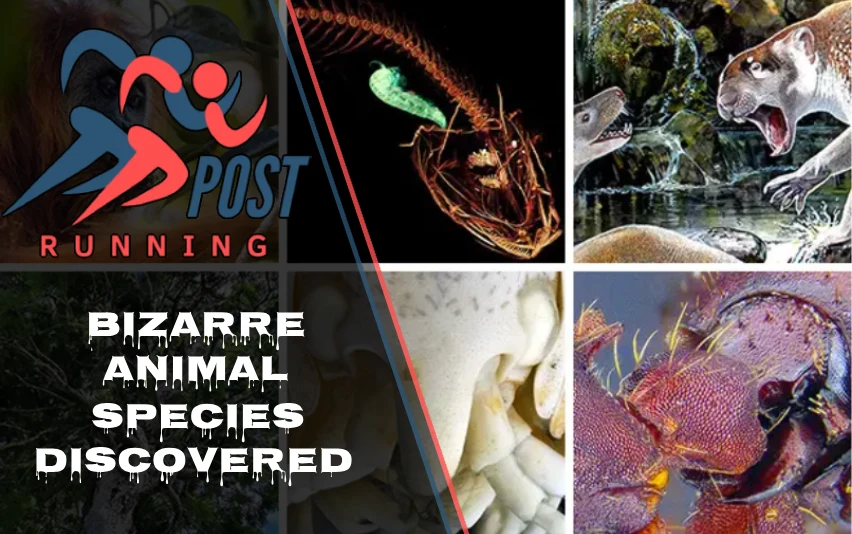Nature never ceases to amaze us with its incredible diversity. In recent years, scientists have stumbled upon some of the most bizarre animal species discovered, showcasing the wonders of evolution and adaptation. From fish with blob-like heads to mice that can swim, these creatures challenge our understanding of the natural world. Let’s dive into the fascinating world of newly discovered species that are redefining what we thought we knew about animal life.
One of the most exciting recent discoveries came from a scientific expedition to Peru, where researchers uncovered an astounding 27 new species. This find alone demonstrates how much there is still to learn about our planet’s biodiversity. Among these discoveries were creatures that seem to have come straight out of a science fiction novel, each with its own unique adaptations that have allowed it to thrive in its specific environment.
Blob-Headed Fish
Imagine swimming in the ocean and coming face to face with a fish that looks like it’s wearing a helmet made of jelly. That’s exactly what scientists encountered when they discovered the blob-headed fish. This peculiar creature has an unusually large, transparent head that looks like a swollen bubble sitting atop its body.
The purpose of this enlarged head remains a mystery to researchers. Some speculate that it might help the fish detect prey or predators, while others think it could be used to amplify sound underwater. Whatever its function, the blob-headed fish stands out as one of the most bizarre animal species discovered in recent times, challenging our notions of what a fish should look like.
Amphibious Mouse
When you think of a mouse, you probably picture a small, furry creature scurrying across the ground. But what if that mouse could swim like a fish? Enter the amphibious mouse, one of the most surprising recent discoveries in the world of rodents.
This remarkable little creature has evolved webbed toes, allowing it to navigate both land and water with ease. It’s an incredibly rare adaptation among rodents, making this mouse a true oddity in the animal kingdom. The discovery of the amphibious mouse highlights how animals can develop unexpected traits to survive in challenging environments.
Other Notable Discoveries
While the blob-headed fish and amphibious mouse might steal the spotlight, they’re not the only strange creatures that have been recently uncovered. Here are a few more notable discoveries that have left scientists scratching their heads:
- Spiny Mouse: This rodent has evolved a unique defense mechanism – it can shed its skin like a lizard to escape predators.
- Short-tailed Fruit Bat: Unlike most bats, this species has an unusually short tail, which affects its flight patterns in interesting ways.
- Dwarf Squirrel: A tiny squirrel species that’s barely larger than a mouse, proving that good things sometimes come in small packages.
These discoveries remind us that there’s still so much to learn about the animal kingdom, even in groups we thought we understood well.
Unusual Evolutionary Traits
Some of the most bizarre animal species discovered aren’t entirely new to science, but their unusual traits continue to baffle researchers. Let’s look at a few examples of animals with truly weird evolutionary adaptations:
The maned wolf, despite its name, isn’t actually a wolf at all. It’s a unique canid species that roams the grasslands of South America. What makes it truly bizarre is the scent of its urine, which smells remarkably like marijuana. This unusual trait has earned it the nickname “skunk wolf” among locals.
Next up is the red-lipped batfish, a creature that looks like it’s wearing bright lipstick. But its appearance isn’t the only strange thing about it. Unlike most fish, the red-lipped batfish can actually walk on the ocean floor using its fins. It’s a prime example of how evolution can lead to unexpected adaptations.
Lastly, we have the saiga antelope, sporting a nose that looks like a mini elephant trunk. This oversized schnoz isn’t just for show – it helps the antelope filter out dust in its arid habitat and warm the air before it reaches the lungs during cold winters. It’s a testament to how form often follows function in nature, no matter how bizarre the result may look.
Vampire Hedgehog
Just when you thought hedgehogs couldn’t get any cuter, along comes a species that might make you think twice. The vampire hedgehog, one of the most bizarre animal species discovered recently, is a new type of soft-furred hedgehog that’s causing quite a stir in the scientific community.
What sets this little critter apart are its unusually large fangs, which give it a vampire-like appearance. While it doesn’t actually suck blood (thankfully!), these enlarged teeth likely serve a specific purpose in its diet or defense mechanisms. The discovery of the vampire hedgehog reminds us that even familiar animals can surprise us with new and unexpected variations.
Pirate Spiders
Arr, matey! The world of arachnids has its own pirates, and they’re just as sneaky as their human counterparts. Two new species of pirate spiders were recently found on a remote Atlantic island, adding to the list of most bizarre animal species discovered.
These crafty spiders got their name from their unique behavior – they “pirate” the webs of other spiders. Instead of building their own webs, they invade those of other spiders, often killing the original owner. It’s a cutthroat world in spider society, and these pirates have found a way to thrive by taking what isn’t theirs. Their discovery highlights the complex and sometimes ruthless strategies that animals develop to survive in competitive environments.
Kermit the Bony Salamander
Sometimes, nature imitates art in the most unexpected ways. Case in point: the fossil of a newly discovered salamander species that bears an uncanny resemblance to everyone’s favorite Muppet, Kermit the Frog.
Dubbed “Kermit the Bony Salamander” by the researchers who found it, this ancient amphibian lived about 40 million years ago. Its most striking features are its large, bug-like eyes and a mouth that seems frozen in a crooked smile, giving it a comical appearance that’s hard to ignore. While it’s not a living species, this fossil discovery reminds us that even in the distant past, nature was creating creatures that could rival the imagination of any puppeteer.
Conclusion
The most bizarre animal species discovered in recent years paint a picture of a natural world that’s far stranger and more diverse than we ever imagined. From blob-headed fish to vampire hedgehogs, these creatures challenge our understanding of animal life and adaptation.
Each of these discoveries underscores the importance of continued research and conservation efforts. As we uncover more of these bizarre species, we’re reminded of how much we still have to learn about our planet’s biodiversity. It’s a call to action to protect and preserve these unique creatures and their habitats, ensuring that future generations can continue to be amazed by the weird and wonderful world of animal life.
In the end, these bizarre discoveries do more than just satisfy our curiosity. They provide valuable insights into evolution, adaptation, and the incredible resilience of life on Earth. As we continue to explore and study our natural world, who knows what other strange and wonderful creatures we might find lurking in the depths of the oceans, the heart of the rainforests, or even in our own backyards?
Discover more fascinating insights—explore Running Posts Today.















